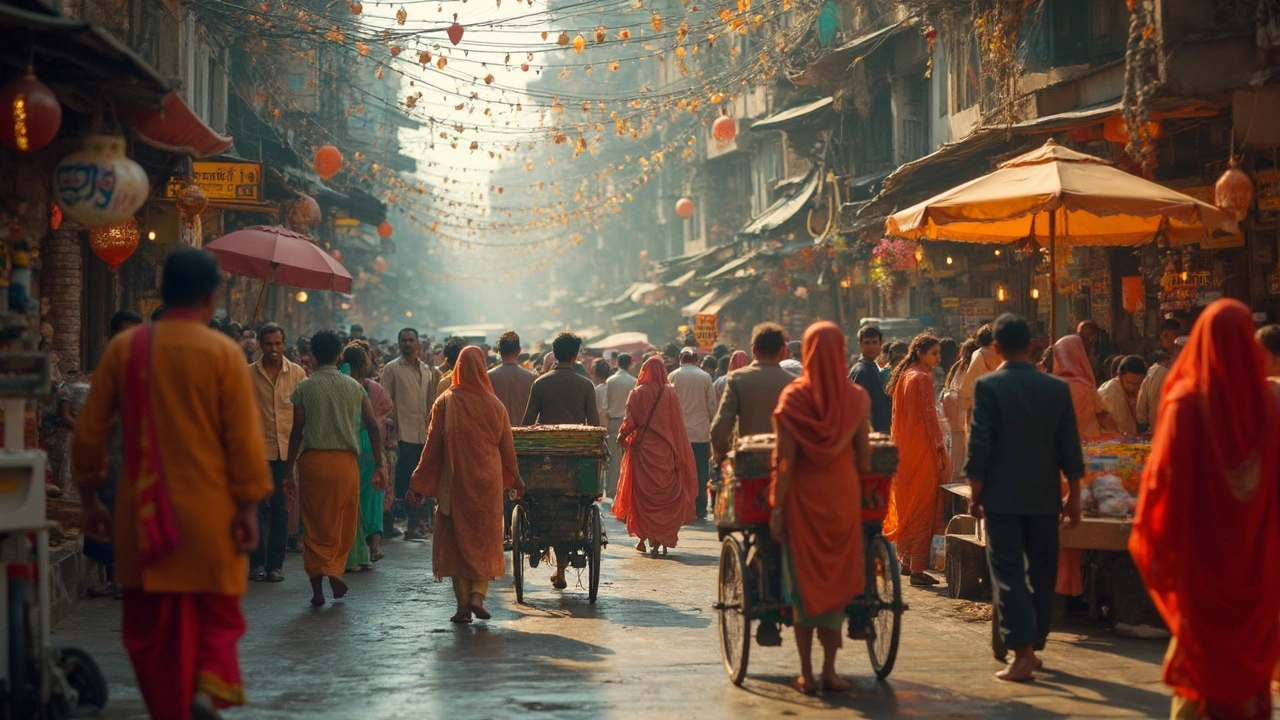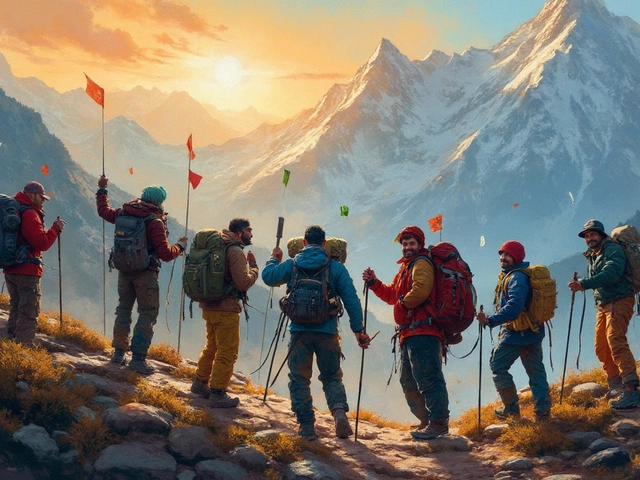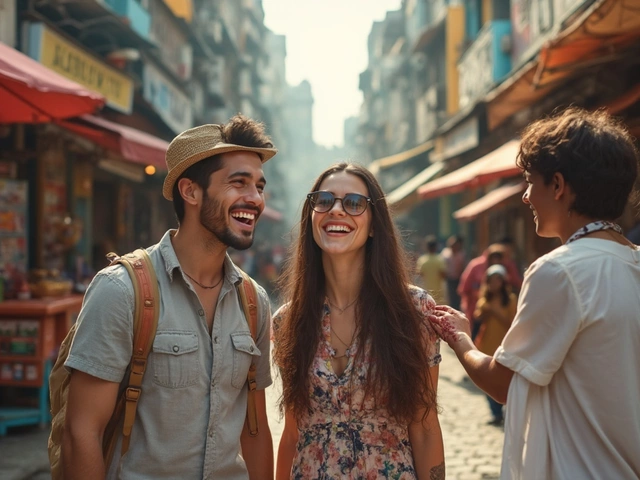Imagine a place where you can eat breakfast in the shadow of an ancient fort, sip chai on a crowded street, and stumble onto a festival just by walking around. That's India—always busy, slightly chaotic, but totally magnetic.
If you've heard about India, chances are someone has mentioned the food. This isn't just hype. No matter where you land, you'll run into dishes that hit you with spice and flavor. And don't think it's all about curry—each region brings its own spin, from buttery dosas down south to tangy chaats up north. Even the street snacks are enough to make you rethink your definition of a meal.
But food is just the opener. India's calendar is packed with festivals that turn whole cities into moving rainbows—think Holi, where everyone gets smacked with colored powder, or Diwali, when every home glows like a lantern. If you want to see a place that takes celebrating seriously, this is it.
- The Food Scene: Bold Flavors, No Apologies
- Festivals and Wild Celebrations
- Cultural Landmarks That Tell Old Stories
- Spiritual Vibes and Unique Traditions
- Everyday Wonders: Street Life and Local Markets
The Food Scene: Bold Flavors, No Apologies
If you ask anyone about India cultural tourism, the food comes up fast. Indian food is a huge draw—not just for its taste, but for the way it completely takes over your senses. The spices are bold, the colors are bright, and there’s always something sizzling somewhere. You don’t travel India just to see sights; you travel to eat your way through it.
Each part of India has its own vibe and menu. North India? Think buttery naan, creamy curries like butter chicken, and street food like pani puri that hits you with spice and tang all at once. Down south, it’s a different story with paper-thin dosas, coconut chutneys, and spicy, rice-based dishes like biryani from Hyderabad that cooks for hours and tastes even better the next day.
No matter where you go, you’ll spot folks drinking chai on street corners or munching samosas. These aren’t just snacks—they’re fuel for daily life. And if you’re nervous about trying street food, just look for the places with the busiest crowds. Locals know what’s good, so follow their lead.
- Did you know India has over 30 types of bread? Roti, paratha, kulcha—each region claims the best.
- The Indian spice market is worth over $5 billion a year. No wonder everything packs a punch.
- Vegetarian or vegan? India has endless options, since nearly 30% of the country doesn’t eat meat.
The curry isn’t always the main event. In the south, you’ll find fish curries and coconut-heavy gravies. In the east, mustard oil and fish rule. And in the west, snacks like pav bhaji or vada pav are quick, spicy, and loaded with flavor.
| Region | Must-Try Dish | Spice Level |
|---|---|---|
| North | Butter Chicken, Rogan Josh, Chole Bhature | Moderate |
| South | Dosa, Hyderabadi Biryani, Fish Curry | Medium to High |
| West | Pav Bhaji, Vada Pav, Dhokla | Mild to Spicy |
| East | Fish Curry, Macher Jhol, Momos | Medium |
Here’s a meal tip: Skip fancy hotels for at least one meal and hit up a local “dhaba.” These roadside diners are famous for cheap, fresh food. The experience is just as good as what’s on your plate. Grab a thali (a tray with small servings of different dishes) to sample a whole bunch of flavors at once.
Festivals and Wild Celebrations
India’s party calendar never runs dry. If you plan your trip right, you’ll get swept up in action that’s louder, brighter, and more thrilling than you’d expect. The country is famous for going all out when it comes to festivals. Some are thousands of years old, packed with rituals you won’t see anywhere else, and all of them bring locals and travelers together in true Indian style.
If there’s one festival that shows off India’s playful side, it’s Holi. This spring bash isn’t just about tossing colored powder. It’s a free-for-all in the streets, with water balloons, thumping music, and spontaneous dance circles. Pro tip: wear the oldest clothes you own—and pack a waterproof case for your phone.
Diwali is another big one, sometimes called the Festival of Lights. People decorate their homes with diyas (tiny lamps), let fireworks fly, and eat sugary sweets until they’re stuffed. It’s about victory of good over evil, but for a visitor, it’s also about soaking up the glow as whole neighborhoods light up like Christmas and New Year’s rolled together.
Not every celebration is wild though. Ganesh Chaturthi, mainly in Mumbai, sees massive clay statues of the elephant-headed god paraded through the streets before a big goodbye dunk in the sea. It’s equal parts devotion and street party. Down south, Onam in Kerala is famous for its huge ‘sadhya’ meals served on banana leaves, and boat races that’ll have you cheering along with the crowds on the riverbanks.
- India cultural tourism spikes during festival season, so book hotels early if you plan your trip around these dates.
- If you’re shy about crowds, try smaller towns—they often have their own festivals that feel just as real, minus the stampedes.
- Always ask before you take photos, especially during religious rituals, and follow any local dress codes to blend in and show respect.
Bottom line: if you want to really see how India comes alive, join it during a festival. The energy is impossible to fake, and you’ll go home with stories you just can’t write from a guidebook.
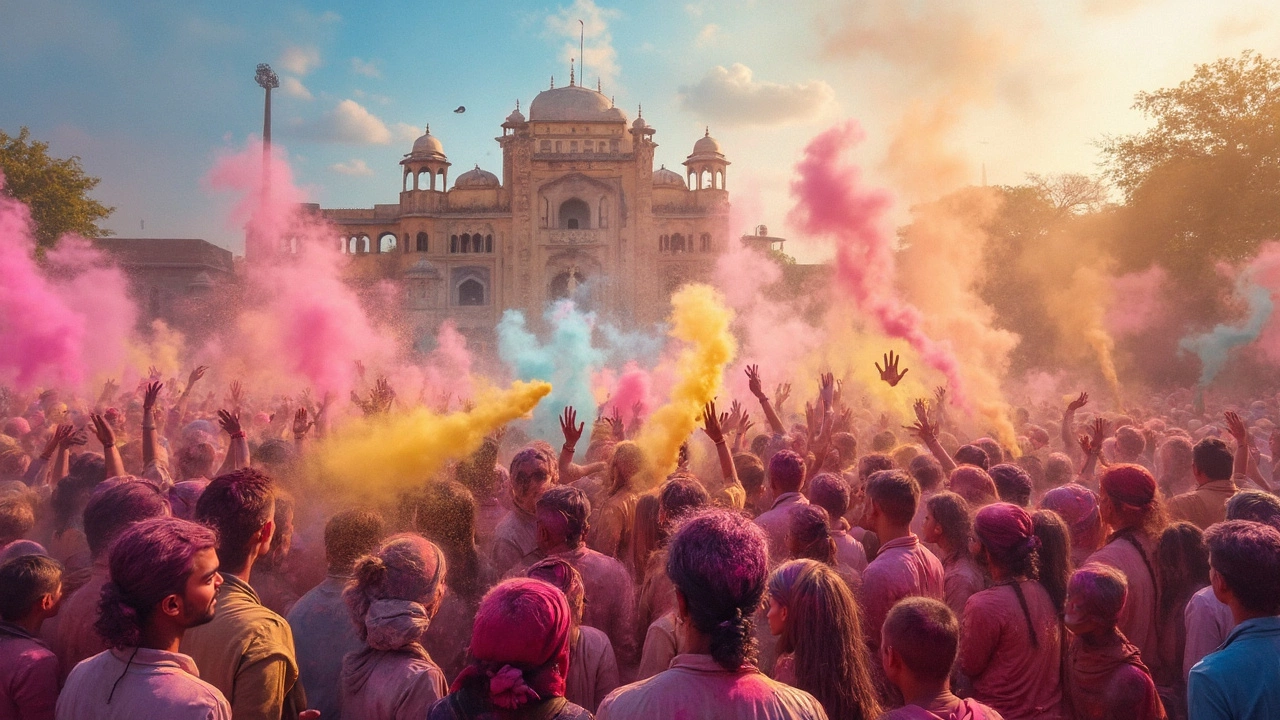
Cultural Landmarks That Tell Old Stories
If you want to dig into what makes India tick, you can't ignore its crazy lineup of landmarks. First up, let's talk about the Taj Mahal in Agra. It's not just another pretty building. This massive white marble tomb draws millions every year—around 6-8 million, to be exact. Built by Mughal emperor Shah Jahan for his wife Mumtaz Mahal, it's the go-to symbol for travel postcards and Instagram shots. Go early in the morning for fewer crowds, or try to catch it under a full moon for a totally different vibe.
Next, the forts of Rajasthan—like Amber Fort near Jaipur and Mehrangarh Fort in Jodhpur—bring serious drama with their cliffside setups and elephant rides. Inside, you'll find painted halls, weapon collections, and courtyards that saw real royal action. If you want to see India's "palace life," Jaipur's City Palace mixes old-world swagger with museums you can actually enjoy.
Down south, there's the ancient city of Hampi, a UNESCO World Heritage Site that's basically an open-air museum. Think gigantic stone temples, market ruins, and rock formations that look straight out of a movie set. It's perfect if you're keen on exploring by bike or just want a break from big city buzz.
Don't skip spiritual hotspots like Varanasi, where people have been bathing in the Ganges River for thousands of years, or the temples of Khajuraho, famous for their intricate and sometimes eyebrow-raising carvings. These places aren't just history lessons—they're still buzzing with rituals and daily life.
| Landmark | Location | Year Built | Annual Visitors |
|---|---|---|---|
| Taj Mahal | Agra, Uttar Pradesh | 1632-1653 | 6-8 million |
| Amber Fort | Jaipur, Rajasthan | 1592 | 1.5 million+ |
| Hampi Ruins | Karnataka | 14th century | 800,000+ |
| Varanasi Ghats | Varanasi, Uttar Pradesh | Ancient | Unknown (millions for festivals) |
When you check out these sites, remember to dress respectably, especially in temples. Shoes usually stay at the door, and photos might not be allowed everywhere. If you're into guided tours, plenty of locals offer them right outside big *India cultural tourism* spots—just get the price upfront.
Spiritual Vibes and Unique Traditions
It’s hard to talk about what India cultural tourism really means without mentioning the mind-blowing spiritual mix here. India is where four major world religions—Hinduism, Buddhism, Jainism, and Sikhism—began. Walk anywhere, and you’ll spot a temple, mosque, church, or tiny shrine tucked between modern shops. Even everyday routines here come loaded with tradition. Ever seen someone draw a rangoli (those colorful patterns) by their door? It’s not just for show. It invites good energy and keeps negativity out.
If you want a taste of how big spirituality is in daily life, check out the rituals on riverbanks at sunrise, especially in Varanasi on the Ganges. Locals practice yoga right where it started thousands of years ago. Meditation retreats are easy to join, whether you’re a newbie or a total pro. And people take pilgrimages seriously. The Kumbh Mela isn’t just a gathering. In 2019, over 220 million people showed up—it was the world’s largest human gathering.
Here’s a quick look at some mind-blowing spiritual facts from India:
| Place | Known For | Annual Visitors |
|---|---|---|
| Varanasi | River rituals, sacred ghats | Over 6 million |
| Golden Temple (Amritsar) | Sikhism's holiest shrine, community kitchen | About 40,000 daily |
| Bodh Gaya | Buddha’s place of enlightenment | 1.5 million |
| Kumbh Mela | Mass Hindu pilgrimage | Record 220 million (2019) |
Another thing to notice: India treats cows as holy, but that’s not just about religion. It affects traffic, food, and even how people do business. If you’re traveling, learn how to greet with a “namaste” and respect traditions like taking shoes off before entering homes and temples. These small details make locals open up.
- Try attending a morning aarti in Varanasi if you want to feel that spiritual buzz firsthand.
- If a festival is going on, don’t just watch—ask locals if you can join. People often invite visitors to their celebrations.
- Respect dress codes in temples and cover your head where it’s required.
Spirituality in India isn’t something you just read about—it’s everywhere. If you really want to get what makes this country tick, step out of your comfort zone, follow the rituals, and soak it all in.
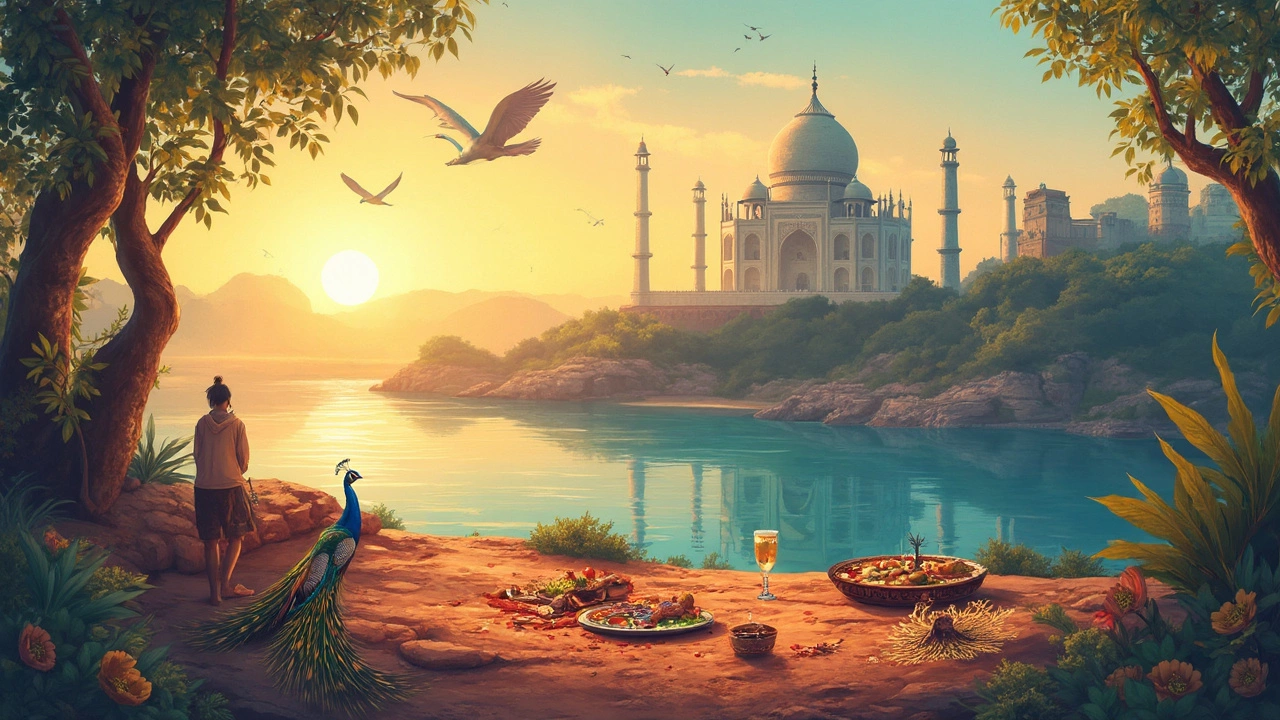
Everyday Wonders: Street Life and Local Markets
There's no better way to get the real feel of India than walking through its streets and markets. The action isn't just inside museums—it's out on the sidewalks where every sense gets a workout. Street vendors call out bargains, kids dart between rickshaws, and the smells—spices, roasting peanuts, incense—come at you from every direction.
Take Chandni Chowk in Old Delhi. It's one of the oldest and busiest markets in the country, running strong since the 17th century. Here you can find everything: mountains of marigolds, silver jewelry, rows of snacks like samosas and jalebis. It's crowded and loud, but that's part of the thrill. Mumbai’s Crawford Market is another classic, packed with fruit sellers and tiny shops. Down south, Bengaluru’s Commercial Street is the place to score clothes and shoes at prices that make you do a double take.
You haven’t really experienced India cultural tourism if you haven’t haggled over the price of a souvenir. Bargaining is expected—sometimes shopkeepers seem disappointed if you just pay their first price. Keep it light-hearted, smile, and if you can’t agree, just thank them and move on. Most locals appreciate a bit of friendly banter.
If you’re nervous about safety or getting lost, stick to daylight hours and main areas. Pickpockets aren’t rare in crowded places, so keep your phone and wallet in a zipped pocket or money belt. On the upside, Indian markets are usually safe if you’re sensible and watch your stuff.
- Bring small change. Many vendors can’t break big bills.
- Try the street food. Head for busy stalls—if locals trust it, it’s probably fine.
- Respect personal space when taking photos. Always ask before snapping portraits.
- Don’t be afraid to sample spices, teas, or sweets—most stall owners love sharing a taste.
For a sense of just how many people love these markets, check out this recent data:
| Famous Market | City | Daily Visitors (Average) | Known For |
|---|---|---|---|
| Chandni Chowk | Delhi | 500,000+ | Spices, street food, fabric |
| Crawford Market | Mumbai | 100,000+ | Fruits, pet shops, local snacks |
| Johari Bazaar | Jaipur | 60,000+ | Jewelry, clothes, sweets |
| New Market | Kolkata | 80,000+ | Textiles, electronics, books |
Markets in India open early and close late—especially around festival time, when the buzz gets even bigger. If you want a slice of real India, skip the tourist shops. Hit the street markets and just take it all in. The chaos is part of the experience.
